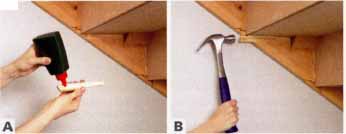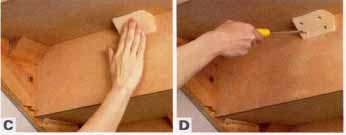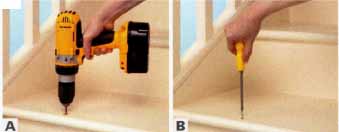Treads and risers are usually wedged tightly in position. The wedges can loosen so the stair moves and creaks. If this happens, you should carefully check all the stairs (see box, below right), and carry out any repairs necessary, from below the stairs if possible, or from above if not. If the treads or risers split, they can be replaced in an open-string staircase. Remove the balusters and the fasteners from the damaged tread or riser (fasteners are under the stairs). Slide out the broken part and use it as a template to cut a new one. Slip the new part into place and replace the fasteners and balusters. You will need professional help to replace treads or risers into a closed-string staircase.
If the nosing of a tread is damaged, it can often be fixed without removing the whole tread. Cut away the damaged area and use it as a template to cut a new section. Then glue and screw the patch in place. This is a method similar to that used for window sills.LOOSE-FITTING NEWEL POST
Take the loose joint apart, clean it, then install it with glue and screws. Adjust the fit of a modular newel turning into the newel base by using wedges and dowels if required. Resin can also be used to form a strong joint.
REPAIRING CREAKING STAIRS FROM BELOW

A. If a wedge is loose under the squeaking stair, remove
it. Use it as a template to cut a new wedge, and apply wood glue to its sides. B.
Drive the new, glued wedge firmly into place. The wedge needs to fit tightly
to prevent any movement in the joint.

C. Once the wedges are tight, glue a reinforcing block across
the joint between the tread and riser. D. Drill pilot holes
through the block and into the stair, taking care not to penetrate the outer
surface. Screw the block tightly into place.
REPAIRING CREAKING STAIRS FROM ABOVE

A. Drill pilot holes through the squeaking or moving tread
and into the edge of the riser below. B. Screw tightly into
the riser. The screw head should recess into the tread. Fill the hole when
you have finished. Repeat along the riser edge.
CHECKING THE STAIRS
The treads and risers of the staircase are exposed to the most damage. Many problems aren’t obvious, so it may be worth checking the condition of old stairs occasionally, and certainly if you detect any movement when using the stairs. If you can get under the stairs, this is the easiest way both to inspect for damage and to fix it—especially if the stairs are carpeted. Ask someone to walk up and down the stairs while you check for any movement in the joints underneath. Mark any that need attention, then strengthen them using the technique above. If you have no access underneath the stairs, you will have to fix them from above (see above).
REPAIRING A BROKEN BALUSTER
If you have a closed-string staircase, simply replace the broken baluster as shown here. If the baluster is secured into the tread of a step, it may be necessary to remove beading around the step in order to replace the spindle. If lots of spindles are damaged, you can replace the whole balustrade.

A. Lever up the fillet below the broken baluster using a
chisel. B. Take the damaged baluster out and use it as a template
to trim a replacement. Slide the new baluster into place. C.
Replace the fillet and pin it into place using a panel pin. You can then decorate
to hide the repair.
PREV: Staircase Preparation
NEXT: Installing
Basement Stairs
Home • •